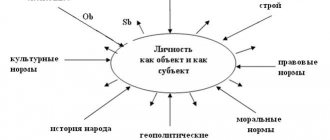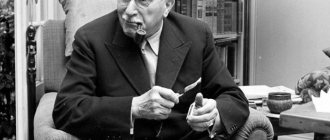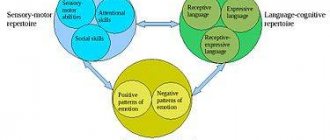Personality theories are various assumptions, a set of hypotheses, a set of concepts and approaches that explain the origin of personality and the determinacy of its development. The theory of personality development seeks not only to interpret its essence, but also to anticipate human behavior. It provides researchers and theorists with the opportunity to understand the nature of the human subject and helps to find answers to rhetorical questions that they are constantly asked. Personality theories in psychology can be briefly represented by seven main concepts, each of which is characterized by its own ideas about personal structure and properties, and has specific methods for measuring them. From this we can conclude that personality is a multidimensional structure and a multifaceted system of psychological characteristics that ensure individuality, temporary and situational constancy of human behavior. In total, there are about forty approaches and concepts aimed at studying the personality of the human subject.
Theories of personality in psychology
It is believed that the human individual is initially born as a human being. At first glance, this statement is true. However, it is based solely on the genetic conditioning of the emergence of innate prerequisites for the formation of human qualities and characteristics. So, for example, a newborn baby’s body shape presupposes the ability to walk upright, the structure of the brain provides the possibility of intellectual development, and the configuration of the hands provides the prospect of using tools. In all of the above, a newborn baby differs from a baby animal. Thus, an infant initially belongs to the human race and is called an individual, while a young animal will be called exclusively an individual throughout its existence.
The concept of “individual” contains the gender identity of a person. An infant and an adult, a sage and a mental retard, an aborigine living in a tribe far from civilization, and a highly educated resident of a developed country can be considered an individual. In other words, describing a person as an individual means not saying anything specific about him. Appearing in this world as an individual, a person acquires a specific social quality and becomes a personality.
Even in childhood, an individual is included in the historically established system of social relationships. The further development of the subject in society forms such an interweaving of relationships that creates him as a person - a systemic social property acquired by a human subject in the process of communicative interaction and objective activity, characterizing the degree and quality of representation of social interactions in the individual.
Since psychology cannot offer a single definition of personality, theories of personality are actively developing in foreign psychology and in domestic science, but the most significant of the foreign concepts are considered:
— psychodynamic theory of personality (the fundamental factor in personality development is innate instincts);
- dispositional personality theory or trait theory, since its adherents were convinced that human subjects have certain dispositions (predispositions, traits) to a certain behavioral response to various “stimuli”; in other words, the followers of this direction assumed that individuals are stable in their own thoughts, constant in actions and feelings regardless of events, circumstances, life experiences;
- phenomenological (consists in the belief that the individual strives for self-realization and is characterized by a positive nature);
cognitive theory of personality (human behavior is greatly influenced by cognitive functions and intellectual processes);
- learning theory or behavioral theory of personality, the main thesis is the belief that personality is the experience acquired by an individual in the process of life.
All of the above personality theories in foreign psychology try to answer the most important question of modern psychological science: what a person is, what his essence is, what drives his development.
Each of the listed approaches represents a specific vision, a separate fragment of the whole picture of such a complex and at the same time integral mechanism called personality.
The behavioral theory of personality is based on the belief that the environment is the source of personality development, that the personality itself does not contain anything from psychological or genetic inheritance. It is exclusively a product of learning, and personality traits are generalized social skills and behavioral reflexes.
The analytical theory of personality, in turn, formulated by Jung, is based on the belief that innate psychological factors determine the development of personality. An individual inherits from his parents ready-made primary ideas, which Jung called “archetypes.”
Within the framework of domestic research in the field of psychological science, the leading role in explaining personality belongs to the activity approach, the basis of which is the subtype of objective activity developed by K. Marx. As a principle that explains mental processes, the category of activity is used in the study of various areas of mental reality. Because in the specific activity of the individual and its generation, not only mental phenomena and the subjective consciousness of the individual, but also social consciousness find objective expression.
Personality theories in Russian psychology can be united by a common main task, which was to study the dependence of the constituent elements of consciousness on the characteristics of the stimuli that cause them. Later, this two-part scheme was reflected in the formula “stimulus equals response” (SR), which cannot be considered entirely correct, since it excludes a meaningful process that carries out real connections between the individual and the objective environment. Concepts of learning do not take into account anything that falls under the headings of consciousness, feeling, imagination and will. The processes that realize the life of subjects in the surrounding reality, their social existence in all their diversity of forms, are activities.
The most famous theories of personality in Russian psychology are associated with the scientific research of supporters of the teachings of L. Vygotsky, in particular, L. Bozhovich and A. Leontiev.
The concept proposed by the domestic psychologist L. Bozhovich covers the period of personal formation from early childhood to adolescence. To describe personality, Bozovic uses concepts that characterize the internal traits and characteristics of individuals. She believed that a person becomes a person who has reached a certain level of development of mental processes, who has the ability to perceive and experience his own “persona” as an indivisible whole, different from the people around him and manifested in the concept of “I”. In other words, at this level of formation of mental processes, a person is able to consciously influence the surrounding reality, modify it and change himself.
Bozhovich, based on the definition of “social situation of formation” and the principle of “leading activity”, previously introduced by L. Vygotsky, showed how in the complex dynamics of the interaction of interpersonal communication and the activities of a child at different stages of his life, a certain view of the surrounding reality is developed, which is called internal position. This position was considered by supporters of this approach to be one of the most significant characteristics of a person, a prerequisite for its development.
The activity theory of personality, developed by A. Leontyev, who continued to develop the theories of L. Vygotsky and S. Rubinstein, considered personality to be a product of social development, and considered its basis to be the totality of social relationships of the individual carried out by his activities. It is through activity that a person can influence things, nature or the people around him. In relation to society, he acts as a person, and in relation to things – as a subject.
Thus, in accordance with the activity aspect of the described concept, individual characteristics or properties of the individual act as components of personality. Proponents of this concept believed that personal properties are formed as a result of activities that are always carried out in a certain socio-historical context. Personality traits, in this regard, are considered as socially (normatively) determined elements. So, for example, perseverance is developed in activities where the individual demonstrates independence.
In contrast to the concept of behaviorism, the activity theory of personality considered the subject’s learning mechanism not to be a reflex, but the process of internalization, through which personal properties are developed.
Afterword
The concepts discussed are similar in some ways, but completely different in others. In particular, there is no clear answer about what ultimately comes first: man or society, nature or the environment.
But if we focus on domestic concepts, we can note that a person becomes a person under the influence of society, through relationships and the assimilation of cultural experience.
You can read more about what personality is in the articles “The concept of personality in psychology: essence and structure” and “Personality orientation - what is it in psychology.”
Basic theories of personality
Over the course of the twentieth century, three core directions have emerged in the practice of world psychological science, later within the framework of which the most significant modern theories of personality were formed.
The main theories of personality in psychology are briefly presented below. These include the humanistic concept, psychoanalytic direction and topological psychology.
The humanistic direction, upon superficial examination, seems to be the opposite of psychoanalytic theory, but the presence of the same characteristics unites them.
In contrast to the approach based on psychoanalytic teaching, which turns to the experienced impressions of the child, repressed into the unconscious, to find the source of activity, the humanistic theory of personality considers the main factor of personal activity to be aspiration towards the future, self-actualization and maximum self-realization.
Supporters of the humanistic movement considered human nature to be essentially good or neutral. The subject is free to choose decisions, therefore, he is responsible for them. A person is an active being, oriented towards distant goals, capable of moving towards them. The main driving force of personal functioning was considered by the followers of this approach to be the desire for self-actualization or the individual’s need to realize his own innate potential.
An important feature of the humanistic direction is the holistic and phenomenological approaches.
The first approach is based on the postulate that the human individual is an integrated whole that cannot be reduced to the individual structures of his personality. The basis of the second direction is psychological reality, in other words, subjective experience according to which reality is interpreted.
In personal formation, according to the concept under consideration, the attitude towards the individual of the environment that is significant to him, especially parents, is important. The emerging self-concept of the baby corresponds to all innate possible potentials only in conditions of receiving complete acceptance and respect from significant adults, that is, unconditional positive attention. A particular personality type is determined by the “quality” of positive attention received by a person throughout his life.
According to Rogers' humanistic concept, there are two opposing personality types: the “maladjusted personality” and the “fully functioning personality.”
The humanistic theory of personality briefly considers the individual to be initially good, possessing innate spiritual qualities and needs (for example, for self-improvement, self-development, knowledge of the world, comprehension of the meaning of one’s own existence, goodness). At the same time, such needs can be temporarily blocked due to unfavorable life circumstances or conditions and not manifest themselves in a person’s behavioral actions.
A. Maslow developed and proposed a hierarchy of needs, which consists of sequential steps. At the first stage are the lowest needs (physiological), in other words, what is controlled by the organs of the body (for example, breathing, food, sexual desire). The next stage is the desire for health and material security (the need for reliability). At the third stage there is a need for communicative interaction, understanding by people, affection (social needs). At the next level, Maslow placed the need for awareness of personal dignity, respect, prestige, and social success. The fifth stage is self-development, that is, the need for self-realization and self-actualization, in understanding one’s own purpose in the world.
Maslow defined the principles of human motivation:
— motives are characterized by a hierarchical structure;
— motives are characterized by dependence on the level, the higher their level, the less significant and vital the corresponding needs are, therefore, the longer they can not be realized;
— while the needs at the lower levels remain unsatisfied, the higher ones remain uninteresting;
- as soon as lower needs are satisfied, they lose their motivating power.
In addition, Maslow notes that the lack of goods, an obstacle to the satisfaction of physiological needs, such as food, rest, safety, leads to the transformation of these needs into leading motives. And, conversely, when basic needs are satisfied, the individual begins to strive to realize higher needs. In other words, it is difficult to strive for self-development when your stomach is empty.
The advantages of the approach to personal development under consideration include the focus on the individual as an active builder of his own life, having unlimited abilities and potential. A disadvantage can be considered indeterminism, neglect of the natural predetermination of human existence.
S. Freud proposed his own interpretation of personality, which had a huge impact on psychotherapeutic practice and theory, psychological science, as well as on culture as a whole.
According to Freud's views, an individual's activity is characterized by dependence on instinctive (subconscious impulses), which include, first of all, the instinct of self-preservation and the sexual instinct. At the same time, in society, instincts cannot reveal themselves as freely as in the animal world, since society imposes a lot of restrictions on the individual, subjects his drives to strict “censorship,” which forces the individual to suppress or inhibit them.
Thus, instinctive drives are repressed from the conscious life of the individual, since they are considered unacceptable, shameful, and compromising. As a result of such repression, they move into the area of the unconscious, in other words, they seem to “go underground.” At the same time, they do not disappear, but retain their activity, which allows them gradually, from the area of the unconscious, to control the behavior of the subject, sublimating (transforming) into various variations of human culture and products of human activity.
In the area of the unconscious, subconscious drives are combined into various complexes depending on their own nature. These complexes, according to Freud, are the real cause of personal activity. Therefore, an important task of psychological science is considered to be the detection of unconscious complexes and the promotion of their disclosure and awareness, which leads to overcoming intrapersonal confrontations (method of psychoanalysis). A striking example of such reasons is the Oedipus complex.
The advantages of the personality theory under consideration lie in the study of the area of the unconscious, the use of clinical methods, and the study of the client’s real problems. Disadvantages include metaphor, subjectivity, and focus on the past.
Topological psychology is based on the term “field” accepted in mathematical science. She explains personal behavior by the fact that various points and zones of living space, that is, the fields in which the subject resides and exists, become the motives of his behavioral response due to the fact that he feels the need for them. When the need for them disappears, the meaning of the object is lost. A supporter of this concept was K. Levin. He did not see the need as predestination of a biological nature, unlike adherents of psychoanalysis. Motivation is not determined by the innate properties of the individual, but by his mutually coordinated actions with the field, which is characterized by the presence of several objects that are attractive in different ways.
The main modern theories of personality are represented by two of the most well-known concepts, in addition to learning theory. These concepts are associated with the names of E. Bern and K. Platonov.
The essence of Platonov’s concept is to consider personality as a structure consisting of individual components, such as: orientation, experience, characteristics of mental functions, biopsychic properties. These listed components determine human behavior in the process of interaction. E. Berne is convinced that a person simultaneously combines several types of behavioral response, each of which is activated due to the influence of certain conditions.
Berne developed the theory of transactional analysis, where a transaction is a unit of communication consisting of a stimulus and a reaction. People, being in the same community, will inevitably start talking to each other or through other actions will reveal their own awareness of the presence of other individuals around. Berne called this phenomenon a transactional stimulus. The subject to whom the transactional stimulus is directed will say or do something in response. He called this phenomenon a transactional reaction.
Berne argued that transactions occur in a certain sequence, one after another. This sequence is not random. It is planned by society, the situation or personality characteristics.
Platonov developed a theory of dynamic functional personality structure and identified four hierarchical substructures of personality. He considered the main personal substructures: personal orientation, experience, characteristics of mental processes and biopsychic properties. Each of the listed substructures, in turn, combines a number of components, which Platonov called “substructures of substructures.”
Personal orientation includes attitudes, worldview, ideals, aspirations, interests and desires. Experience consists of habits, skills, abilities and knowledge. Features of mental processes combine sensations, perceptions, mental activity, emotional sphere, memory, will and attention. Biopsychic properties consist of temperament, gender and a number of age characteristics. In addition, all substructures of the personality are imprinted by the subject’s character and abilities.
Birth order in the family: life styles according to Adler
Adler was the first to notice that in the same family children can have completely different characters. The firstborn is a child who can only be envied. After all, parents usually give all their love to their first child. But this happens for the time being - until another child appears in the family.
When the second is born, the firstborn becomes “a monarch who was unjustly dethroned.” He begins to fight for the lost love of his parents. But all his efforts are doomed to failure. And over time, he realizes the futility of his attempts. His parents are always too busy and indifferent for him. In addition, they are now endowed with much more power than they once were: after all, they can appeal to the inappropriate immaturity of the older child. Their response to the firstborn's demand for love is punishment.
As a result, those who were born first in the family develop a special lifestyle. They accustom themselves to isolation, not needing affection or anyone's approval. In addition, Adler notes, the eldest is always inclined to lead.
What is the situation with the second child? For him, his older brother or sister is always his role model. The current situation pushes him or her to compete with him or her, trying to beat his records. If there are other children in the family, then the second child also fights with them for parental love. And this only increases his ambitions. The lifestyle of an adult who has grown from a second child is a continuous desire to prove his superiority. Unconsciously, he strives to show: I am better than my older brother or sister.
The last child occupies a special position. He is the one who will never experience the feeling of being “dethroned.” But if the family is poor, then he will constantly have to use the things and toys of his elders. The younger child will also develop feelings of inferiority. But he has one advantage: his motivation to surpass his elders is the highest.
Adler considers the position of the only child in the family unique. Since he has no one to compete with, such children’s rivalry with their father becomes especially strong. The lifestyle of an only child who has become an adult is egocentrism mixed with dependence.
Freud's personality theory
The second half of the 19th century marked itself with the separation of psychology into a separate branch of science, the main task of which was to identify the basic structures of the human psyche through introspection methods in laboratories.
Therefore, the emergence of a radically new approach to the study of human individuals has had a stunning effect. The concept of personality formulated by a young psychiatrist from Vienna, S. Freud, presented the human subject not as a rational being aware of his own behavior, but as a creature in an eternal confrontation, the origins of which lie in the unconscious.
Freud's theory of personality is based on the view that the human subject is always in a state of confrontation with society, since this society drives him into a framework in which he cannot realize all his own drives and desires.
Freud believed that the process of development of the psyche is determined by the need to adapt to an environment that is predominantly hostile. He considered innate drives and unconscious aspirations to be the driving forces behind the formation of the psyche.
Freud based his psychoanalytic theory on the postulate that the foundation of the development of the psyche is the emotions and motivational sphere of the individual, and cognitive development is a consequence of motivational development, while other schools were based on the belief that the formation of the psyche is determined by the development of the intellectual sphere.
Freud argued that the human psyche combines three levels, namely: the conscious layer, the preconscious layer and the unconscious level. It is in them, as he assumed, that the key personality structures are located. The content of the unconscious layer is not understandable, while the content of the preconscious level can be comprehended by a person, but this requires significant effort.
Freud identified three elements in the personality structure: Id, Ego, Super-Ego. The component element Id is located in the unconscious layer. It is actually the driving basis for the development of the psyche, since innate unconscious inclinations are localized in it, which strive for discharge, satisfaction, and similarly determine the activity of the subject. Freud distinguished the two most essential innate unconscious inclinations - the instinct of life and death, which are in a hostile relationship with each other, forming the basis for a thorough, biological internal confrontation. The lack of awareness of such confrontation is associated with the struggle between aspirations, which occurs at the unconscious level. In addition, human behavior is determined by the simultaneous influence of both of these instincts.
A constituent element of the Ego, Freud also considered it as an innate structure. It is located simultaneously at the conscious level and in the preconscious. The content of the Id expands during the life of the child, while the content of the Ego, on the contrary, narrows, since the baby is born with the presence of the so-called “oceanic sense of Self,” which contains the entire surrounding world.
The structure of the Super-Ego is not innate, since it is formed throughout the baby’s life. The mechanism of its formation is identification with close persons of the same sex, the qualities and traits of which become the content of the Super-Ego.
Freud emphasized that there is a precarious balance between the three components of personality described.
Conclusion:
There are many more views on the processes of human development. Other theories of personality development are behaviorism, the existential direction, humanistic theories, and the already mentioned psychoanalysis. Each of these concepts occupies a special place in psychological knowledge.
When thinking about our own development, we do not demand precision and mathematical rigor from psychological theories. After all, life is like the bed of a river, and personality cannot be described using a single formula, just as it is impossible to give an exact definition to each wave in this river.
Topics: Psychology of women, Psychology of men, Personal growth









